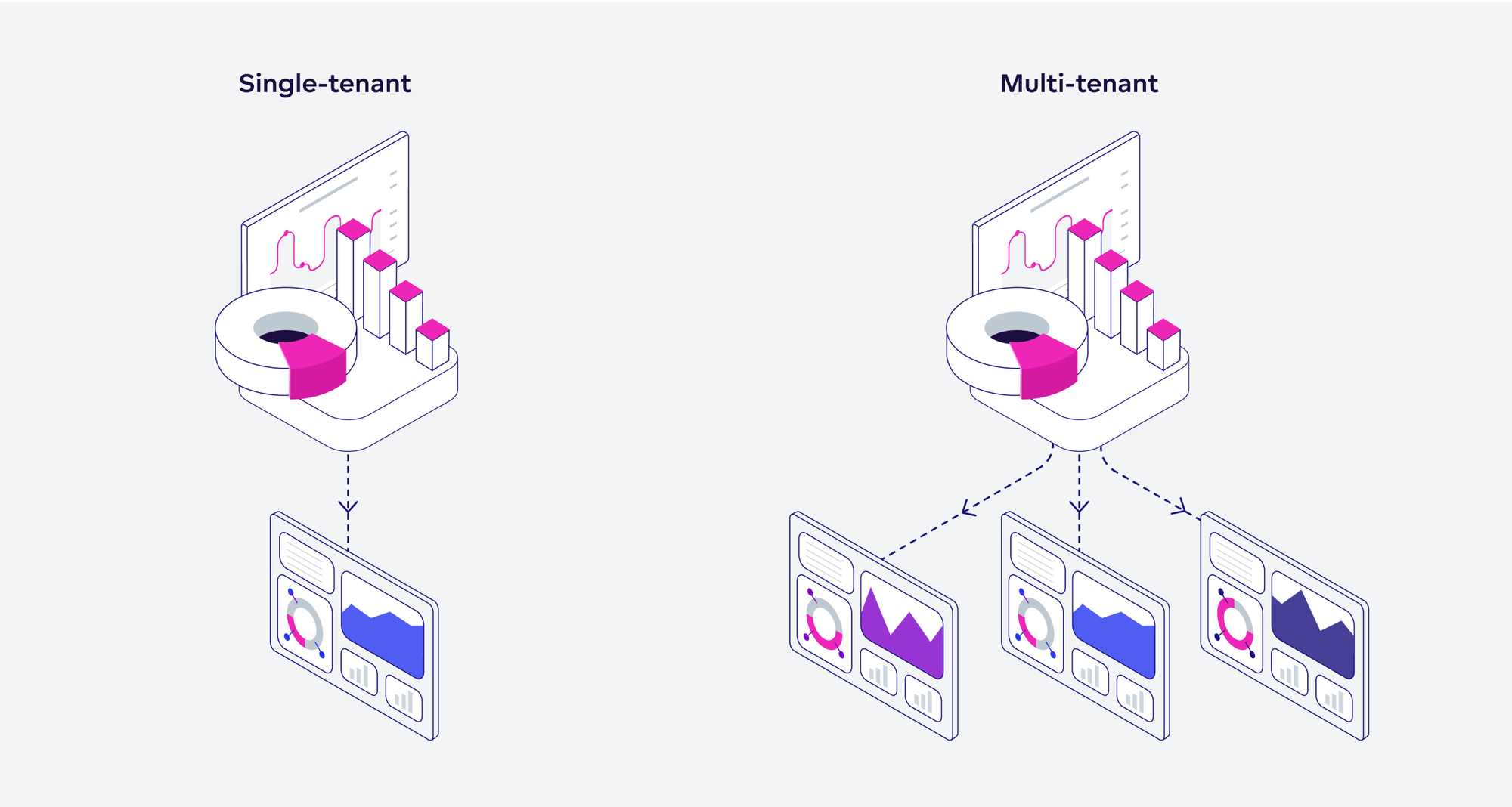Is multi-tenant architecture right for you? Learn about its advantages in our comprehensive guide!
Multi-tenant architecture, or multi-tenancy, is a software architecture that can run multiple instances of an application on the same cloud server, which is responsible for serving multiple tenants simultaneously. Each client’s group of users is given access to isolated software in a shared environment. This type of architecture allows companies to assign a single infrastructure to several end users or organizations with groups of users, rather than individually managing the maintenance and updates of multiple environments.
What Is Multi-Tenant Architecture?
Multi-tenant architecture hosts multiple clients or tenants inside one environment. Each tenant’s data is isolated from others and secured. This arrangement is similar to an apartment complex, where each tenant has a private apartment within a single building. The main advantages are lower costs, scalability, quick customization without coding, and centralized updates and maintenance.
How Multi-Tenancy Works
The term “tenant” refers to the customers or user groups that share access to hardware or software resources. Multi-tenancy is often used in cloud computing, enabling service providers to offer a more affordable option on the public cloud. It can also be used by software-as-a-service (SaaS) companies or companies that want to distribute software among employees in different locations.
Multi-tenant architecture works by creating multiple virtual machines (VMs) on the same physical or virtual server that all share the same hardware or software, but that operate as separate entities in complete independence from one another. This guarantees user security and privacy.
Multi-Tenant vs. Single-Tenant Architecture
Single-tenancy is largely seen as the “deluxe” option, in that a client operates in a solely dedicated environment. In a multi-tenant environment, each customer shares the software application along with a single database, so multiple people from the same company can access the database. Still, even in multi-tenancy, each tenant is isolated from other tenants.
The chief advantage of multi-tenant hosting is that it is less expensive. Resource pooling greatly reduces the cost since companies only pay for what they need. And since multi-tenancy is part of a SaaS provider, companies are not paying for on-premises hardware.
Functions like system monitoring and servicing the deployment become shared among all of the customers, which makes it less expensive as the cost is spread around. The table below highlights the differences between the two approaches.
| Multi-tenancy | Single-tenancy | |
|---|---|---|
| Cost | More affordable; shares costs with other tenants | All costs paid by single-user |
| Hardware resource access | Hardware shared among tenants, divided using VMs | Server is used solely by single tenant |
| Software resource access | Same software instance can be accessed by multiple users simultaneously | All software instances are completely unique and isolated to the single-user entity |
| Client responsibilities | All maintenance work and software updates delegated to the cloud service provider | The client is responsible for software updates, patches, backup, restore, and disaster recovery |
| Type of cloud | Public cloud | Private cloud |
| System security | Reduced interactions with out-of-cloud sources minimize exposure to malicious software | Full control over who accesses the cloud environment and the data moving in and out |
| Availability | “Noisy neighbor” syndrome with other tenants taking up computing resources | Exclusive access to all of the cloud’s computing power at all times |
| Efficiency | Only use the resources you need | There’s wasted potential and poor efficiency if the environment isn’t run to full capacity |
| Customizability | Minimal customization options; one-size-fits-all | Single tenants can customize the software environment to suit their needs |
3 Examples of Multi-Tenant Architecture
In using virtual systems in VMs, a single system would have to handle numerous instances, all running several versions or even different operating systems. Each of those instances also has to run its own application, along with its associated database.
When implemented into a multi-tenant architecture, all instances within a VM have to share the same base operating system, applications, and database access. This is the same model that’s used in infrastructure-as-a-service (IaaS), platform-as-a-service (PaaS), and SaaS offerings.
Since IaaS, PaaS, and SaaS rely on sharing hardware and software resources, they use multi-tenancy in running their environment. This also enables them to create high-scalability offers for customers.
URL-Based SaaS
URL-based SaaS, also known as web-based SaaS, is a method of delivering software service over the internet that can be accessed through a dedicated URL. This approach to SaaS is easier for the user, and allows for less complex software and hardware management.
Using a URL as the primary method of SaaS deployment is also easier for the host service provider, as they’d only have to manage a single domain and database.
For the host, data management and security are handled at the application level rather than individually for each client. Many SaaS providers operate using this model, especially those that put a web app interface between the user and the primary database. In addition, the host can set up different Domain Name System (DNS) entries depending on the customer’s needs and how they’d like their traffic to be filtered.
The difference in URL allows the clients some level of customization. Of course, it’s limited since the architecture is still multi-tenant, but clients can implement their own local testing or even changes to the user interface (UI) and user experience (UX).
Multi-Tenant SaaS
In a multi-tenant SaaS structure, multiple customers are made to share the same software and hardware in order to cut costs and management efforts. Usually, this is done through the sharing of a single instance of the software along with its supporting data and information.
This approach tends to be slightly more complex for the host due to the number of databases and schemas accessed by clients, along with the restrictions needed at the database level. However, this often allows for more direct interaction with the database, cutting back on lag and wait times.
Another benefit is the increase in computing capacity per customer. Individual customers won’t have to worry about server and processing power capacities—they simply access the system and pay according to the resources they use.
Similarly to other approaches to multi-tenancy, this reduces the customization options for customers. Dedicated upgrades tend to be time-consuming and more complex to implement without negatively affecting the rest of the environment for the remainder of the customers.
Explore IT Tech News for the latest advancements in Information Technology & insightful updates from industry experts!
Source: https://www.datamation.com/cloud/what-is-multi-tenant-architecture/







